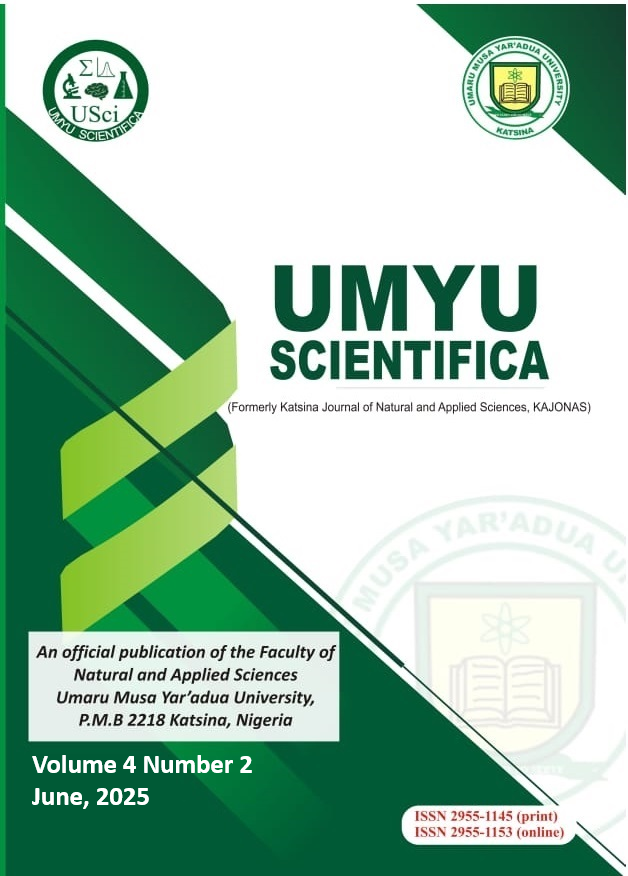A Geospatial Analysis of Crimes Patterns in Niger Republic Using Hotspots and K-Means Cluster
DOI:
https://doi.org/10.56919/usci.2542.018Keywords:
Niger Republic, Crime, Hotspot, Cluster, Elbow curve, k-meansAbstract
Study’s Excerpt:
• Crime patterns in Niger were analyzed using crime maps and k-means clustering techniques.
• 61.53% of crime hotspots are in the west, bordering Mali, Burkina Faso, and Benin Republic.
• Southern regions (33.33%) face crimes like rebellion and counterfeiting near Nigeria's border.
• Northern hotspots (15.38%) show illegal arms and corruption near Libya, Chad, and Algeria.
• Study suggests cross-border security and optimized law enforcement in high-crime clusters.
Full Abstract:
This study is an investigation of some crimes in the Niger Republic. The methods consist of determining the crime patterns using crime maps and cluster analysis (k-means). It was observed from the hotspot analysis that 61.53% of the crimes like violence or assault, narcotics, rebellion, murder, counterfeit money, scam, stealing, and abuse of confidence are observed in the western part of the country that has a border with Mali Republic, Burkina Faso, Benin republic. 33.33% of the hotspots are observed in the southern part of the country with a border with Nigeria and concern crimes like recels, rebellion, counterfeit money, and criminal association. 15.38% of the hotspots are observed in the north that have borders with Libya, Chad, and Algeria and are concerned with crimes like Illegal arms possession and corruption. For the k-means cluster, the optimum clusters were determined first using the elbow method. It was observed that most clusters have optimum numbers of four and five except the embezzlement crime type, which has three clusters. Based on the above, there is a need to strengthen cross-border security collaboration, optimize resource allocation in high-risk regions, and enhance law enforcement efforts.
References
Almanie, T., Mirza, R., & Lor, E. (2015). Crime prediction based on crime types and using spatial and temporal criminal hotspots. International Journal of Data Mining & Knowledge Management Process (IJDKP), 5(4), 1-19. https://doi.org/10.5121/ijdkp.2015.5401
Borg, A., & Boldt, M. (2016). Clustering residential burglaries using modus operandi and spatiotemporal information. International Journal of Information Technology & Decision Making, 15(1), 23–42. https://doi.org/10.1142/S0219622015500339
Brown, S. E., Esbensen, F., and Geis, B. (1998). Criminology explaining crime and its context Anderson publishing Co.
Crime, G. I. A. T. O. (2021). Global organized crime index 2021. Global Initiative Against Transnational Organized Crime.
Danbazau, A. B. (2007). Criminology justice (2nd ed.). Ibadan: Spectrum Books Limited.
Gyamfi, J. (2002). An analysis of the broad crime trends and patterns in Ghana. Journal of Criminal Justice, 30(3), 229–243. https://doi.org/10.1016/S0047-2352(01)00138-6
Jain, E., & Jain, S. K. (2014, September). Using Mahout for clustering similar Twitter users: Performance evaluation of k-means and its comparison with fuzzy k-means. In 2014 International Conference on Computer and Communication Technology (ICCCT) (pp. 29–33). IEEE. https://doi.org/10.1109/ICCCT.2014.7001465
Kodinariya, T., & Makwana, P. (2013). Review on determining number of cluster in k-means clustering. International Journal of Advance Research in Computer Science and Management Studies, 1(6), 90–95.
Laukkanen, M., Santtila, P., & Sandnabba, K. (2008). Predicting spatial patterning of burglary crime series. Forensic Science International, 176(1), 224–235. https://doi.org/10.1016/j.forsciint.2007.09.011
López-Rubio, E., Palomo, E. J., & Ortega-Zamorano, F. (2018). Unsupervised learning by cluster quality optimization. Information Sciences, 436, 31–55. https://doi.org/10.1016/j.ins.2018.01.007
Motcho, K. H. (2004). Croissance urbaine et insécurité dans la ville de Niamey. Geographica Helvetica, 59(3), 199–207. https://doi.org/10.5194/gh-59-199-2004
Nath, S. V. (2006, December). Crime pattern detection using data mining. In 2006 IEEE/WIC/ACM International Conference on Web Intelligence and Intelligent Agent Technology Workshops (pp. 41–44). IEEE. https://doi.org/10.1109/WI-IATW.2006.55
Numbeo. (2015). Crime index for country 2015. Retrieved June 30, 2017, from [URL if available]
United Nations. (1995). States in disarray: The social effects of globalization. UN Research Institute for Social Development.
Usman, U., Yakubu, M., & Bello, A. Z. (2012). An investigation on the rate of crime in Sokoto State using principal component analysis. Nigerian Journal of Basic and Applied Sciences, 20(2), 152–160.
Van Patten, I. T., McKeldin-Coner, J., & Cox, D. (2009). A micro-spatial analysis of robbery perspective hotspotting in a small city. Crime Mapping: A Journal of Research and Practice, 1(1), 7–32.
Volasik, M. (2018). Gang violence predictability using risk terrain modeling to study gang homicide and assaults in East Los Angeles. Journal of Criminal Justice, 58(3), 10–21. https://doi.org/10.1016/j.jcrimjus.2018.06.001
Downloads
Published
How to Cite
Issue
Section
License
Copyright (c) 2025 Boubakar Dodo, Umar Usman, B K Asare, Y M Ahijjo

This work is licensed under a Creative Commons Attribution-NonCommercial 4.0 International License.




